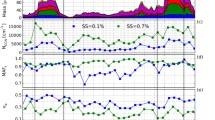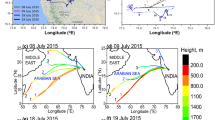Abstract
An adiabatic bin-sized cloud parcel model is developed by incorporating the multi-chemical-component (MCC) aerosol effects into the UWyo single-chemical-component (SCC) parcel model. The effects of MCC aerosols on the warm cloud microphysics in North China are investigated with the model. The simulations are initialized using the data on chemical components and number size distribution of aerosols measured during the IPAC (Influence of Pollution on Aerosols and Cloud Microphysics in North China) campaign in spring 2006. It is found that the MCC aerosols in North China increase the cloud droplet number concentration (CDNC) and decrease the effective radius more efficiently than pure ammonium-sulfate aerosols. It is also shown that the MCC aerosols in North China can narrow the cloud droplet spectra (CDS) by increasing CDNC in small size and decreasing CDNC in large size. Our results indicate that aerosol chemical components and their size distributions can influence the microphysics of warm clouds, and thus affect atmospheric radiation and precipitation. This should attract more attentions in weather and climate change research in the future.
Similar content being viewed by others
References
Lohmann U, Feichter J. Global indirect aerosol effects: A review. Atmos Chem Phys, 2005, 5: 715–737
IPCC. Climate change 2007: The physical science basis. In: Solomon S, Qin D, Manning M, et al., eds. Contribution of Working Group I to the Fourth Assessment Report of the Intergovernmental Panel on Climate Change. Cambridge and New York: Cambridge University Press, 2007
Yin Y, Levin Z, Reisin T G, et al. The effects of giant cloud condensation nuclei on the development of precipitation in convective clouds-A numerical study. Atmos Res, 2000, 53: 91–116
Zhao C S, Peng D Y, Duan Y. The impacts of sea-salt and nss-sulfate aerosols on cloud microproperties. J Appl Meteor Sci, 2005, 16: 417–425
Zhang L, Michelangeli D V, Taylor P A. Influence of aerosol concentration on precipitation formation in low-level warm stratiform clouds. Aerosol Sci, 2006, 37: 203–217
McFiggans G, Artaxo P, Baltensperger U, et al. The effect of physical and chemical aerosol properties on warm cloud droplet activation. Atmos Chem Phys, 2006, 6: 2593–2649
Snider J R, Guibert S, Brenguier J. Aerosol activation in marine stratocumulus clouds: 2. Köhler and parcel theory closure studies. J Geophys Res, 2003, 108(D15): 8629, doi: 10.1029/2002JD002692
Nenes A, Charlson R J, Facchini M C, et al. Can chemical effects on cloud droplet number rival the first indirect effect? Geophys Res Lett, 2002, 29: 1848, doi: 10.1029/2002GL015295
Ervens B, Feingold G, Kreidenweis S M. Influence of water-soluble organic carbon on cloud drop number concentration. J Geophys Res, 2005, 110: D18211, doi: 10.1029/2004JD005634
Zhao C S, Ishizaka Y, Peng D Y. Numerical study on impacts of multi-component aerosols on marine cloud microphysical properties. J Meteor Soc Jpn, 2005, 83: 977–986
Zhao C S, Ishizaka Y. Numerical study on cloud microphysics of stratocumulus-topped marine boundary. Acta Meteor Sin, 2004, 62: 87–95
Mircea M, Facchini M C, Decesari S, et al. The influence of the organic aerosol component on CCN supersaturation spectra for different aerosol types. Tellus B-Chem Phys Meteorol, 2002, 54: 74–81
Yin Y, Levin Z, Reisin T, et al. Seeding convective clouds with hygroscopic flares: Numerical simulations using a cloud model with detailed microphysics. J Appl Meteor, 1999, 39: 1460–1472
Tang I N, Munkelwitz H R. Water activities, densities, and refractive indices of aqueous sulfates and sodium nitrate droplets of atmospheric importance. J Geophys Res, 1994, 99: 18801–18808
Pruppacher H R, Klett J D. Microphysics of Clouds and Precipitation. Dordrecht: Kluwer Academic Publishers, 1997
Shulman M L, Jacobson M C, Chalson R J, et al. Dissolution behavior and surface tension effects of organic compounds in nucleating cloud droplets. Geophys Res Lett, 1996, 23: 277–280
Ma J Z, Chen Y, Wang W, et al. Strong air pollution causes haze-clouds over China. J Geophys Res, 2010, 115, doi: 10.1029/2009JD013065
Wang W, Ma J Z, Hatakeyama S, et al. Aircraft measurements of vertical ultrafine particles profiles over Northern China coastal areas during dust storms in 2006. Atmos Environ, 2008, 42: 5715–5720
Pan X L, Yan P, Tang J, et al. Observational study of influence of aerosol hydroscopic growth on scattering coefficient over rural area near Beijing maga-city. Atmos Chem Phys, 2009, 9: 7519–7530
Metzger S, Lelieveld J. Reformulating atmospheric aerosol thermodynamics and hygroscopic growth into fog, haze and clouds. Atmos Chem Phys, 2007, 7: 3163–3193
Decesari S, Facchini M C, Fuzzi S, et al. Characterization of water-soluble organic compounds in atmospheric aerosol: A new approach. J Geophys Res, 2000, 105: 1481–1489
Huang X F, Hu M, He L Y. Determination of water soluble organic acids in PM (2.5) of atmosphere in Beijing City. Environ Sci, 25: 21–25
Hobbs P V. Aerosol-Cloud-Climate Interactions. San Diego: Aca demic Press, 1993
Twomey S. The nuclei of natural cloud formation, Part II: The supersaturation in natural clouds and the variation of cloud droplet concentration. Geofis Pura Appl, 1959, 43: 243–249
Shi L X, Duan Y. Observations of cloud condensation nuclei in North China. Acta Meteor Sin, 2007, 65: 644–652
Duan J. Study on influence of aerosol on region precipitation in North China. Doctoral Dissertation. Beijing: Peking University, 2008
Sheng P X, Mao J T, Li J G, et al. Atmospheric Physics. Beijing: Peking University Press, 2003
Fitzgerald J W. Effect of aerosol composition on cloud droplet size distribution: A numerical study. J Atmos Sci, 1974, 31: 1358–1367
Zhao C S, Tie X X, Brassuer G, et al. Aircraft measurements of cloud droplet spectral dispersion and implications for indirect aerosol radiative forcing. Geophys Res Lett, 2006, 33: L16809, doi: 10.1029/2006GL026653
Author information
Authors and Affiliations
Corresponding author
Rights and permissions
About this article
Cite this article
Yang, S., Ma, J., Hu, Z. et al. Influence of multi-chemical-component aerosols on the microphysics of warm clouds in North China. Sci. China Earth Sci. 54, 451–461 (2011). https://doi.org/10.1007/s11430-010-4075-z
Received:
Accepted:
Published:
Issue Date:
DOI: https://doi.org/10.1007/s11430-010-4075-z




